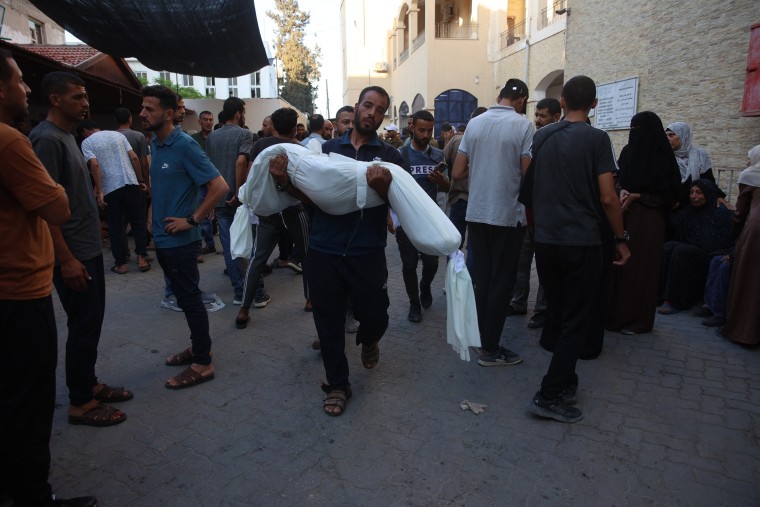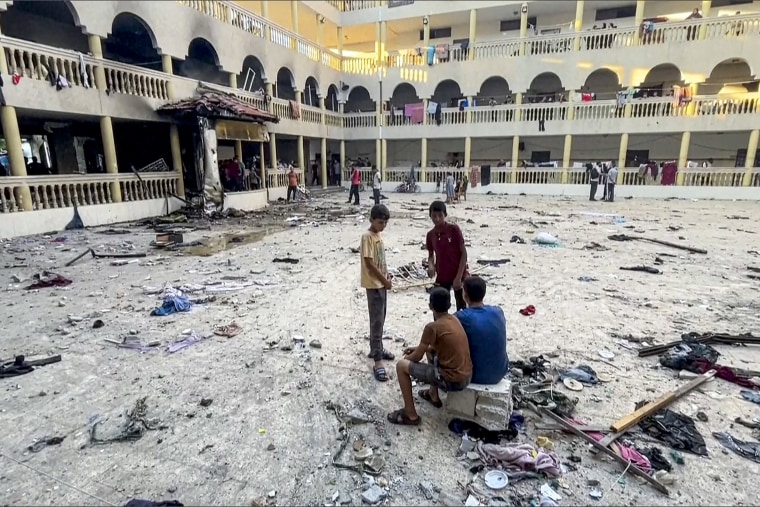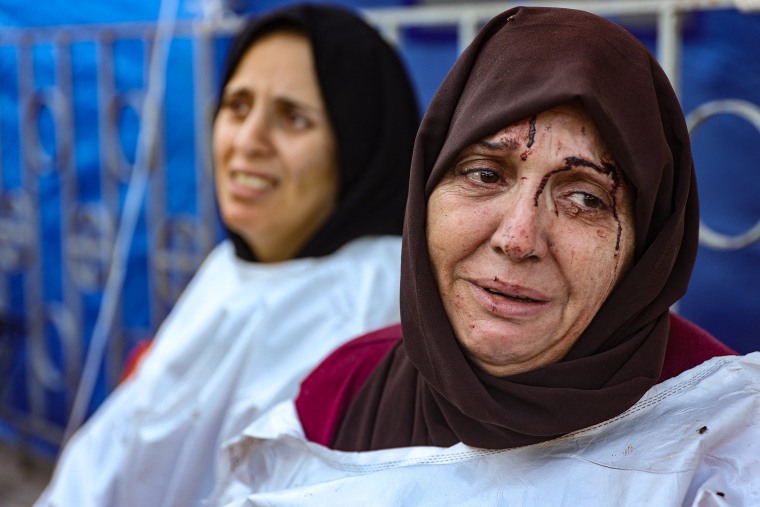An airstrike by the Israel Defense Forces on a school-turned-shelter killed at least 100 people and injured dozens more Saturday morning, according to Gaza’s civil defense, in what would be one of the deadliest attacks in the 10-month war as mediators discussed ongoing efforts to de-escalate soaring tensions in the region.
The strikes hit the Tabeen school in Gaza City, including the mosque inside it, during dawn prayers. Video filmed by an NBC News crew showed significant damage to parts of the school, which witnesses say was hit without an evacuation warning from the IDF.
In response to the attack, the White House issued a statement Saturday, saying it was “deeply concerned” about reports of civilian casualties, and urged Israel to take measures “to minimize civilian harm.”
The IDF issued several statements on Saturday and Sunday, disputing the death toll and the scale of the strike’s impact.
On Saturday afternoon, Rear Adm. Daniel Hagari, an IDF spokesperson, said the reported number of deaths, “do not distinguish between combatants and non-combatants, and they do not match the information held by the IDF,” Hagari said, referring to the Gaza’s government information office. The death toll cited by NBC News is from civil defense, the agency that provides emergency services in Gaza.
The strike was targeting a Hamas command center embedded in the school compound, the IDF said, and that “numerous steps were taken to mitigate the risk of harming civilians,” including the use of precise munitions, aerial surveillance and intelligence information.
The IDF and Shin Bet, Israel’s internal intelligence service, said in a statement Saturday that “at least 19 Hamas and Islamic Jihad terrorists were eliminated.” The IDF did not provide its own estimate for the number of civilians killed in the attack.
The IDF’s statement also disputed the extent of the damage, saying the munitions used “cannot cause the amount of damage reported,” by the information office.
In its statement, the White House said, “We know Hamas has been using schools as locations to gather and operate out of, but we have also said repeatedly and consistently that Israel must take measures to minimize civilian harm.”
“We mourn every Palestinian civilian lost in this conflict, including children, and far too many civilians continue to be killed and wounded,” the statement said, adding that “this underscores the urgency of a ceasefire and hostage deal, which we continue to work tirelessly to achieve.”
On Sunday, the Israeli military ordered the evacuation of a neighborhood in Khan Younis, that it previously declared a humanitarian zone, saying that rockets had been fired from there towards Israel. The warning said the IDF would “act forcefully” and said the area was now considered “a dangerous combat zone.”
Hundreds of families left their homes on Sunday seeking refuge. In a separate statement Sunday, the IDF said it had struck 30 targets across Gaza in the last day.

Hamas denied having a command center in the school and called Israel’s claim that 19 militants were killed in the strike “false and baseless,” and described the attack a “heinous massacre.”
NBC News is unable to independently verify whether there was a command center at the school.
Video gathered by NBC News from inside the school showed severe destruction. Walls were shattered, and broken rafters hung from the ceiling. Rubble and debris — foam mattresses, pillows, books, cans of food, the twisted carcass of a refrigerator — covered the ground, some of it soaked in blood.
Rescuers gathered the dead and wrapped them in white shrouds and other makeshift coverings. Their loved ones sat nearby, mourning for them.
In an interview with The Associated Press, a witness identified as Abu Anas described the scene at the school: “There were people praying. There were people washing, and there were people upstairs sleeping including children, women and old people.”
The projectile struck them “without warning,” Abu Anas said. “We recovered them as body parts.”
Mohammed Al-Mogher of Gaza Civil Defense told NBC News that three missiles tore through the school, where he estimated that some 4,200 displaced people were sheltering, before fire spread across the building.
Al-Mogher, who heads the agency’s documentation department, said the process of identifying the bodies was “extremely complex.”
“Most of them have not been identified due to the disappearance of their features and the melting of the bodies, as most of them were molten remains,” he said, adding that there were more than 60 bodies missing, and that most of the injured were in critical condition, with complete burns and amputated limbs.
Some have died on the operating tables “due to a lack of medical equipment,” Al-Mogher said.

The civil defense, he added, continued to suffer from severe shortages “and are working with simple manual equipment, which has not enabled the teams to perform their duties effectively and save lives.”
Mahmoud Saber Basal, an official spokesperson for the civil defense, said the casualty count may increase “due to the severe situation of the injured people.”
“There are also a lot of people who are missing,” Basal said. “There are a lot of bodies that cannot be identified, body parts that are cut. These people have names and families but it is very difficult for the medical teams and even the civilians to identify them.”
Hamas said the strike was “a dangerous escalation” and called on the international community to “take urgent action to stop these massacres.”
Khalil Al-Hayya, the deputy head of Hamas in Gaza, told Al Jazeera on Saturday that he believed Israel was “beyond negotiation or dialogue, beyond decisions.”
According to the United Nations, 477 out of 564 schools in Gaza have been directly hit or damaged since the current conflict began on Oct. 7, when Hamas attacked southern Israel, resulting in the death of about 1,200 people, and another 240 were kidnapped. In Gaza, about 40,000 have been killed in the war, 90,000 have been injured, and the overwhelming majority of the population has been displaced.
Saturday’s strike on the Tabeen school came during renewed efforts to de-escalate soaring tensions in the region following the assassination of Hamas political leader Ismail Haniyeh in Tehran and a senior Hezbollah commander in Beirut.

American, Qatari and Egyptian mediators have continued to push for Israel and Hamas to achieve a cease-fire agreement. On Friday, U.S. Secretary of State Antony Blinken spoke with Israeli Defense Minister Yoav Gallant to discuss de-escalating tensions.
Spokesperson Matthew Miller said Blinken reiterated the urgent need to reach a cease-fire in Gaza that would secure the release of the hostages, allow a surge of humanitarian assistance, and create the conditions for broader regional stability. (115 hostages remain in Gaza, about 40 of whom are believed to have died.)
On Saturday, Iran’s mission to the United Nations underlined the importance of a cease-fire in Gaza, saying that its retaliation for Haniyeh’s assassination “will be timed and conducted in a manner not to the detriment of the potential ceasefire.”
It added that it will also recognize any cease-fire agreement accepted by Hamas.
A spokesperson for Jordan’s Ministry of Foreign Affairs and Expatriates, Ambassador Sufyan Al-Qudah, said the timing of the attack on the Tabeen school — as mediators seek to resume talks over a cease-fire deal — was an indication of the Israeli government’s efforts to “obstruct and thwart” negotiations.

And in a sign of the White House’s rising frustration with Israel, national security spokesperson John Kirby publicly rebuked comments made by far-right Israeli Finance Minister Bezalel Smotrich, who called the cease-fire negotiations with Hamas a “dangerous trap.”
Kirby called the comments “ridiculous” and “dead wrong,” and accused Smotrich of “misleading the Israeli public” by suggesting that a hostage deal was a surrender to Hamas.
“Don’t allow extremists to blow things off course, including extremists in Israel taking these ridiculous charges against the deal,” he said, adding that the onus was on both Israel and Hamas to agree to a deal.
The U.S. State Department said Washington will provide Israel with $3.5 billion to spend on U.S. weapons and military equipment, as first reported by CNN on Friday. The amount comes from a $14 billion supplemental funding bill for Israel that was passed by Congress in April.
In a statement posted on X, the Palestinian mission to the U.N. said that the Palestinian presidency held the U.S responsible for the strike on the Tabeen school, citing the release of military aid to Israel.
“The U.S. must end the blind support that leads to the killing of thousands of innocent civilians, including children, women, and the elderly,” it said.

